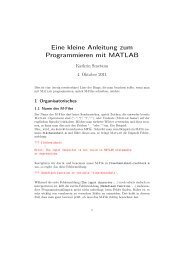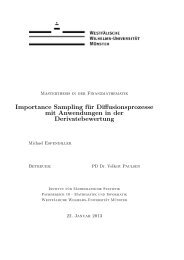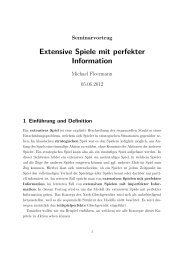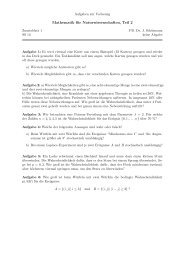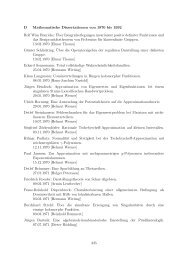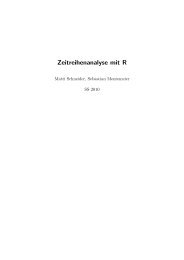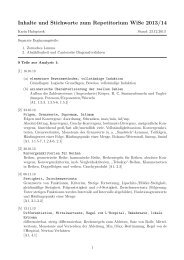Margulis Lemma
Margulis Lemma
Margulis Lemma
You also want an ePaper? Increase the reach of your titles
YUMPU automatically turns print PDFs into web optimized ePapers that Google loves.
18 VITALI KAPOVITCH AND BURKHARD WILKING<br />
Using the definition of dt r (s) and the volume estimate (9) this gives<br />
∫<br />
− dt r (s)(p, q) dµ(p) dµ(q) ≤ C 2 (n) · r · ε + 2rC 1 ε =: C 3 rε.<br />
B r(c(t)) 2<br />
This completes the induction step with C(n) = C 3 and ε 0 = 1<br />
2C 3<br />
. In order to<br />
remove the restriction ε ≤ ε 0 one can just increase C 3 by the factor 4, as indicated<br />
at the beginning.<br />
□<br />
Proof of Proposition 3.6. Put g t,i (x) = ‖∇·Xi t ‖(x). First notice that by Hölder<br />
∫ 1<br />
0<br />
Mx(g t,i (x))(c i (t)) dt ≤<br />
∫ 1<br />
0<br />
u t,i (c i (t)) dt → 0.<br />
Let λ i → ∞ and put r i = R λ i<br />
, where R > 1 is arbitrary. By <strong>Lemma</strong> 3.7 there is<br />
S i ⊂ B ri (c i (0)) with<br />
• vol(S i ) ≥ (1 − δ i ) vol(B ri (c i (0))) with δ i → 0 and<br />
• φ t (S i ) ⊂ B 2ri (c(t)) for all t.<br />
In the following we assume that i is so large that δ i ≤ 1/2, and r i ≤ 1/100. As<br />
in the proof of <strong>Lemma</strong> 3.7 this easily implies that there is a universal constant<br />
C = C(n) with<br />
and<br />
Using that φ it|Bri (c(0)) ′<br />
vol(B 2ri (c i(t)))<br />
vol(B ri (c i(0))) ≤ C 2<br />
for all t and all i.<br />
is measure preserving, we deduce<br />
∫ 1<br />
− Mx(g t,i )(φ it (p)) dt dµ(p) ≤ C<br />
∫S i 0<br />
≤<br />
by (5)<br />
C<br />
∫ 1<br />
0<br />
∫ 1<br />
0<br />
∫<br />
−<br />
B 2ri (c i(t))<br />
Mx(g t,i )(q) dt dµ(q)<br />
Mx(Mx(g t,i ))(c i (t)) dt<br />
∫ 1<br />
≤ C · C 2 Mx(gt,i) α 1/α (c i (t)) dt<br />
0<br />
∫ 1<br />
= C · C 2 u t,i (c i (t)) dt → 0.<br />
Thus we can find ˜δ i → 0 and a subset B ri (c i (0)) ′′ ⊂ S i with<br />
vol(B ri (c i (0))) − vol(B ri (c i (0)) ′′ ) ≤ ˜δ i min vol(B r<br />
q∈B ri (c i/R(q))<br />
i(0))<br />
∫ 1<br />
0<br />
Mx(g t,i )(φ it (q)) ≤ ˜δ i for all q ∈ B ri (c(0)) ′′ .<br />
Recall that r i = R λ i<br />
with an arbitrary R. By a diagonal sequence argument it is<br />
easy to deduce that after replacing ˜δ i by a another sequence converging slowly to<br />
0 we can keep the above estimates for r i = Ri<br />
λ i<br />
with R i → ∞ sufficiently slowly.<br />
Combining this with <strong>Lemma</strong> 3.7 shows that f i = φ i1 : (λ i M i , c(0)) → (λ i M i , c(1))<br />
has the zooming in property.<br />
Let ˜X i t be a lift of Xt i to the universal covering ˜M i of M i . Consider the integral<br />
curve ˜c i : [0, 1] → ˜M i of ˜Xt i with ˜c(0) = ˜p i . Clearly ˜c i is a lift of c i and by the<br />
0




